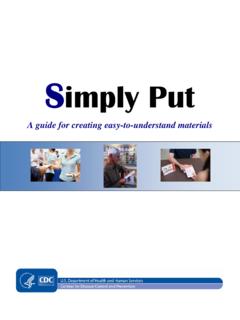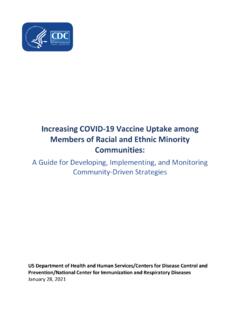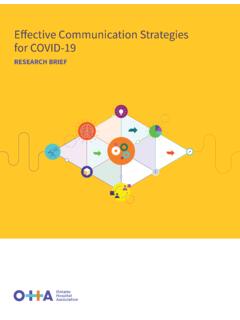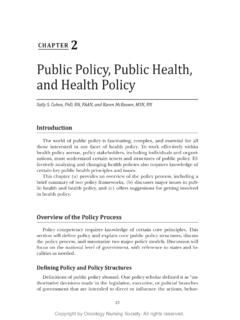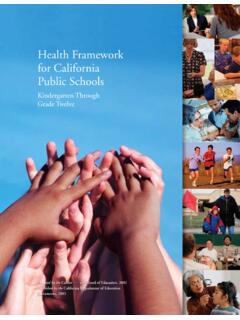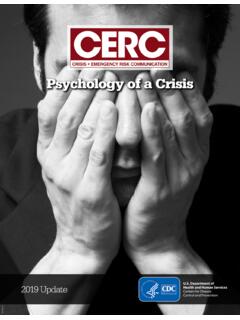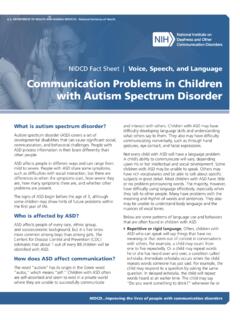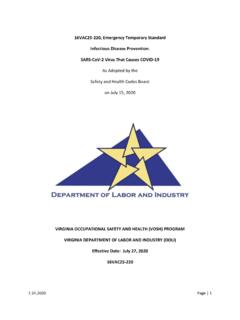Transcription of DEPARTMENT OF HEALTH & HUMAN SERVICES
1 DEPARTMENT OF HEALTH & HUMAN SERVICES Centers for Medicare & Medicaid SERVICES 7500 Security Boulevard, Mail Stop C2-21-16 Baltimore, Maryland 21244-1850 center for Clinical Standards and Quality/Survey & Certification Group Ref: QSO-20-39-NH DATE: September 17, 2020 TO: State Survey Agency Directors FROM: Director Survey and Certification Group SUBJECT: Nursing Home Visitation - COVID-19 Background Nursing homes have been severely impacted by COVID-19, with outbreaks causing high rates of infection, morbidity, and The vulnerable nature of the nursing home population combined with the inherent risks of congregate living in a healthcare setting have required aggressive efforts to limit COVID-19 exposure and to prevent the spread of COVID-19 within nursing homes.
2 In March 2020, CMS issued memorandum QSO-20-14-NH providing guidance to facilities on restricting visitation of all visitors and non-essential HEALTH care personnel, except for certain compassionate care situations, such as an end-of-life situation. In May 2020, CMS released Nursing Home Reopening Recommendations, which provided additional guidance on visitation for nursing homes as their states and local communities progress through the phases of reopening. In June 2020, CMS also released a Frequently Asked Questions document on visitation, which expanded on previously issued guidance on topics such as outdoor visits, compassionate care situations, and communal activities. 1 Information on outbreaks and deaths in nursing homes may be found at Memorandum Summary CMS is committed to continuing to take critical steps to ensure America s healthcare facilities are prepared to respond to the Coronavirus disease 2019 (COVID-19) Public HEALTH Emergency (PHE).
3 Visitation guidance : CMS is issuing new guidance for visitation in nursing homes during the COVID-19 PHE. The guidance below provides reasonable ways a nursing home can safely facilitate in-person visitation to address the psychosocial needs of residents. Use of Civil Money Penalty (CMP) Funds: CMS will now approve the use of CMP funds to purchase tents for outdoor visitation and/or clear dividers ( , Plexiglas or similar products) to create physical barriers to reduce the risk of transmission during in-person visits. 2 While CMS guidance has focused on protecting nursing home residents from COVID-19, we recognize that physical separation from family and other loved ones has taken a physical and emotional toll on residents. Residents may feel socially isolated, leading to increased risk for depression, anxiety, and other expressions of distress.
4 Residents living with cognitive impairment or other disabilities may find visitor restrictions and other ongoing changes related to COVID-19 confusing or upsetting. CMS understands that nursing home residents derive value from the physical, emotional, and spiritual support they receive through visitation from family and friends. In light of this, CMS is revising the guidance regarding visitation in nursing homes during the COVID-19 PHE. The information contained in this memorandum supersedes and replaces previously issued guidance and recommendations regarding visitation. guidance Visitation can be conducted through different means based on a facility s structure and residents needs, such as in resident rooms, dedicated visitation spaces, outdoors, and for circumstances beyond compassionate care situations.
5 Regardless of how visits are conducted, there are certain core principles and best practices that reduce the risk of COVID-19 transmission: Core Principles of COVID-19 Infection prevention Screening of all who enter the facility for signs and symptoms of COVID-19 ( , temperature checks, questions or observations about signs or symptoms), and denial of entry of those with signs or symptoms Hand hygiene (use of alcohol-based hand rub is preferred) Face covering or mask (covering mouth and nose) Social distancing at least six feet between persons Instructional signage throughout the facility and proper visitor education on COVID-19 signs and symptoms, infection control precautions, other applicable facility practices ( , use of face covering or mask, specified entries, exits and routes to designated areas, hand hygiene)
6 Cleaning and disinfecting high frequency touched surfaces in the facility often, and designated visitation areas after each visit Appropriate staff use of Personal Protective Equipment (PPE) Effective cohorting of residents ( , separate areas dedicated COVID-19 care) Resident and staff testing conducted as required at 42 CFR (h) (see QSO-20-38-NH) These core principles are consistent with the centers for disease control and prevention (CDC) guidance for nursing homes, and should be adhered to at all times. Additionally, visitation should be person-centered, consider the residents physical, mental, and psychosocial well-being, and support their quality of life. T he risk of transmission can be further reduced through the use of physical barriers ( , clear Plexiglas dividers, curtains).
7 Also, nursing homes should enable visits to be conducted with an adequate degree of privacy. Visitors who are unable to adhere to the core principles of COVID-19 infection prevention should not be permitted to visit or should be asked to leave. By following a person-centered approach and adhering to these core principles, visitation can occur safely based on the below guidance . 3 Outdoor Visitation While taking a person-centered approach and adhering to the core principles of COVID-19 infection prevention , outdoor visitation is preferred and can also be conducted in a manner that reduces the risk of transmission. Outdoor visits pose a lower risk of transmission due to increased space and airflow. Therefore, all visits should be held outdoors whenever practicable.
8 Aside from weather considerations ( , inclement weather, excessively hot or cold temperatures, poor air quality), an individual resident s HEALTH status ( , medical condition(s), COVID-19 status), or a facility s outbreak status, outdoor visitation should be facilitated routinely. Facilities should create accessible and safe outdoor spaces for visitation, such as in courtyards, patios, or parking lots, including the use of tents, if available. When conducting outdoor visitation, facilities should have a process to limit the number and size of visits occurring simultaneously to support safe infection prevention actions ( , maintaining social distancing). We also recommend reasonable limits on the number of individuals visiting with any one resident at the same time.
9 Indoor Visitation Facilities should accommodate and support indoor visitation, including visits for reasons beyond compassionate care situations, based on the following guidelines: a) There has been no new onset of COVID-19 cases in the last 14 days and the facility is not currently conducting outbreak testing; b) Visitors should be able to adhere to the core principles and staff should provide monitoring for those who may have difficulty adhering to core principles, such as children; c) Facilities should limit the number of visitors per resident at one time and limit the total number of visitors in the facility at one time (based on the size of the building and physical space). Facilities should consider scheduling visits for a specified length of time to help ensure all residents are able to receive visitors; and d) Facilities should limit movement in the facility.
10 For example, visitors should not walk around different halls of the facility. Rather, they should go directly to the resident s room or designated visitation area. Visits for residents who share a room should not be conducted in the resident s room. NOTE: For situations where there is a roommate and the HEALTH status of the resident prevents leaving the room, facilities should attempt to enable in-room visitation while adhering to the core principles of COVID-19 infection prevention . Facilities should use the COVID-19 county positivity rate, found on the COVID-19 Nursing Home Data site as additional information to determine how to facilitate indoor visitation: Low (<5%) = Visitation should occur according to the core principles of COVID-19 infection prevention and facility policies (beyond compassionate care visits) Medium (5% 10%) = Visitation should occur according to the core principles of COVID-19 infection prevention and facility policies (beyond compassionate care visits) High (>10%)










